a remote paper in process for "the politics of presence" mixed media colloquium, stanford, 23, 24, 25 May 2007
this paper will be developed online each afternoon of the colloquium....
Nick Kaye, The Presence Project
Media Entities and a Politics of Presence
interventions from another time/space

TONY OURSLER, Pink-too-long Fluid, 2007
aluminium, acrylic, LCD screen, DVD player
57 x 55 x 4.5 inches
144.8 x 139.7 x 11.4 cm
COURTESY OF THE ARTIST AND LEHMANN MAUPIN GALLERY,
NEW YORK
The eye of Pink-too-long Fluid looks up to the left, then out. Then to the right, and continues, slowly. Eventually, the eye fades to lips, that perform an extended, slow kiss on the lens, almost filling the video image, leaving a coloured smear over the opening. Then returns to the eye.
Television confirms the diagnosis that the boundaries between inside and outside are blurred: the diagnosis that "self" is an outdated concept (Acconci 2001: 372)
Interruption
"Psychologically, one may view media as an evolutionary facilitator of the fractured self." (Oursler in London 1994: 8)
Tony Oursler's media entities are staged in a repetition of the same in difference, an uncanny amplification and exposure of the performance of presence in overtly mediatized forms and signs.
Foregrounding simulation, representation, reference, and mirroring, while multiplying media, they invite the onlooker to assign them a quality of presentness that questions the presence and integrity of the self who views.
Acting as surrogates for the presence of others, the media entity tests the viewer's emotional identification through a time-based image and a three-dimensional form that is purposefully reductive.
The Pink-too-long Fluid is the body pared down and abstracted toward a collapse of recognisable features; a hybrid media entity, it mimics of a kind of empathetic, puzzled, part-articulate observer of the gallery visitor. The media entity has time: it looks back.
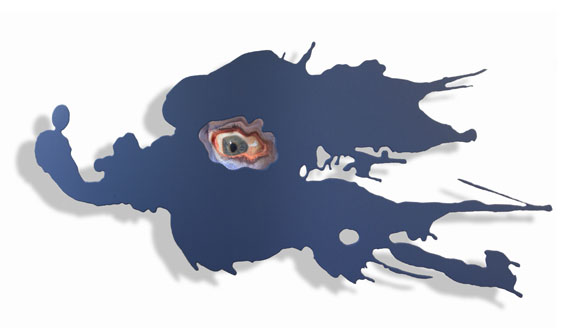
TONY OURSLER, Bluerealisation with Head, 2007
aluminium, acrylic, LCD screen, DVD player
92 x 42 x 4.5 inches
233.7 x 106.7 x 11.4 cm
COURTESY OF THE ARTIST AND LEHMANN MAUPIN GALLERY,
NEW YORK
Bluerealisation with Head opens up a dimension behind the picture plane. The eye attempts to look down, the eyelid closes, opens. Eventually, the video performer moves back. A mouth takes the place of the eye, whispering. The performer moves in and out of shadow and focus, at times looking out, then head shaking rapidly, then a whisper: "see outside range of your vehicle....see...yes, I cried". Then the eye returns.
Space, media and everyday practice
Such a 'reduction' acts as a foil to Oursler's implicit examination of the operation of the media structure: as this 'irreducible entity' appears, in time and repetition, as something to be identified with, so it emerges as an operation of the media taking place primarily on the viewer.
Important here is the relationship to Oursler's Blob (2004), a form whose projected movement onto a fixed form proposes a somatic connection, a bodily identification. Oursler writes:
The blob's movements are alien yet oddly famliar. Pulling and stretching. Like peristaltic movement. Like the way things move through your body by contractions which result in locomotion. You understand this is linked to your bowels and intestines, because even though this motion is involuntary, it is conscious on some level. It is essentially a wave, the universal form of energy transmission divided into peaks and troughs like a bad ocean. Unending waves, wave after wave, wash away your shape. Now formless, You are the blob.
Now, you want to help the blob. (Oursler ....)
Oursler's entities interrupt and amplify the viewer's negotiation - and performance - of media spaces and processes.
Reflecting on his early use of dummies, substitute performers animated by facial projections, Oursler approached this identification of the media and a realisation of self as "a deeper relationship: an internal mirror of media structures and individual practices in relation to it" (Oursler 1995: 12). Later, he remarks that: "I have the idea that the media space has transposed realism to create a new space of everyday life. Dismally, we have gone over to the other side of the mirror" (Oursler 2005: 45)
Media entities work to interrupt the constitution of the self in an everyday practice of media consumption.
In this process, the entity's 'presence' remains key.
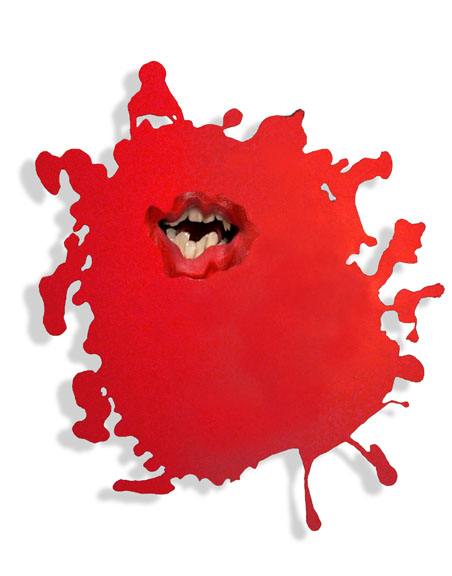
TONY OURSLER, Red "Love Hurts" Laboratory, 2007
aluminium, acrylic, LCD screen, DVD player
58 x 47 x 4.5 inches
147.3 x 119.4 x 11.4 cm
COURTESY OF THE ARTIST AND LEHMANN MAUPIN GALLERY,
NEW YORK
The lips, in Red "Love Hurts" Laboratory, are pursed repeatedly, with some difficulty. Then, a very quiet whisper.
Close up, to listen, its construction seems apparent: the hard surface, the brushstrokes, the screen surface and distortion of the mouth - the skin of the performer blushed red with make-up. The whisper is difficult to make out. It's necessary to get close enough to be confided in: "it happens...".
Presence as simulation
"hallucination does not feign presence but (...) presence is hallucinatory" (Deleuze, 1993: 125)
Media entities do not simply represent or mediate a 'presence' located 'elsewhere,' for presence is not an originary point, an authentic or autonomous quality to be depleted in its reproduction or repetition.
For Frank Biocca, writing in The Journal of Computer-Mediated Communication, social presence, being there with others, implies simulation:
Rather than seeing social presence as a partial replication of face-to-face communication, we should more generally see social presence as a simulation of another intelligence. The simulation is run in the body and mind of the perceiver, and models the internal experience of some other moving, expressive body. It is a simulation because the simulation occurs whether or not the moving object has intelligence or intentionality, whether the “other” is a moving human being or an animation composed of nothing more than moving patterns of ink. The definition above suggests that social presence applies to the mediated experience of all forms of “intelligence.” This perceived intelligence might be another human, a non-human intelligence such as an animal, a form of artificial intelligence, an imagined alien or a god. (Biocca 1997)
Media entities repeat, emphasize and amplify this simulation, foregrounding the function of electronic media as surrogate and mirror.
Important here, too, is the repetition, the loop, and the relationship to the object, the construction of a back-and-forth rhythm between the watcher and the watched. Key to this in Oursler's work is a disruption of the image, a puncturing of the work's completion.
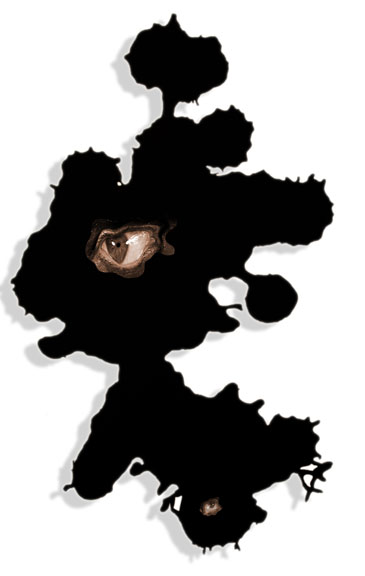
TONY OURSLER, (Usually) Black Anythingyou want, 2007
aluminium, acrylic, LCD screen, DVD player
79 x 45 x 4.5 inches
20.7 x 114.3 x 11.4 cm
COURTESY OF THE ARTIST AND LEHMANN MAUPIN GALLERY,
NEW YORK
Periodically, the eyes (large and small) of (Usually) Black Anythingyou want switch from colour to a negative black and white image. Then switch back. The eyes look about, blink, deferring attention across the room.
Forms and "thought forms"
Linked to this perception of their being there, these 'entities' resist resolution into the forms they explicitly invoke. Here, Oursler asserts painting, relocating ‘video art’ into conventions of surface, paint, the hand, and abstraction, so recollecting the early shift from paint to video evident in his single channel tapes.
Oursler recalls:
THE POSSIBILITY OF ENTERING A VIDEO SPACE WAS RADICAL AND ULTIMATELY DESIRABLE FOR ME, A MEMBER OF THE FIRST GENERATION OF TELEVISION YOUTH. MY EXPERIMENTS IN PAINTING ENDED UP IN FRONT OF THE CAMERA AND I OFTEN PAINTED WHILE LOOKING THROUGH THE CAMERA. (…) THROUGH THE LENS MY PICTURES COULD BE ELECTRIFIED WITH ALL THE ATTRIBUTES OF LIFE; IF THEY NEEDED A HAND OR MOUTH I WOULD JUST CUT A HOLE AND STICK IT THE BODY PART THROUGH. IF SCENES NEEDED SOUNDS OR WORDS THEY COULD BE SPOKEN OR WRITTEN INTO THE TAPE; MUSIC COULD BE MADE TO ADD COLOR. I WAS STRUCK BY THE ABILITY OF THE CAMERA TO ALTER THE LAWS OF PHYSICS; TO TRANSFORM MATTER, SPACE AND TIME, INANIMATE TO ANIMATE: WORLDS UNTO THEMSELVES. (Oursler 1997: pages unnumbered)
At the same time, the abstraction and painterly aspects of these entities is loaded: these works play with play, denial, objectness, emotional investment, science fiction, gothic, colour theory, and animation.
Designed to mimic an awareness of the time and attention of the viewer, Oursler's entities amplify and extend the impulse evident in his early sngle-channel videotapes, which, he recalled:
were designed to mirror a thought pattern or process. This is in opposition to a film grammar, which is about looking outward and attempting to replace the eye. My work is designed to work with the way we really see, which has to do with a very complicated referencing system full of memory, conjecture, and multi-voxed narratives. (Oursler in Janus 1999: 70-1)
In this context, the entities respond implicitly to the media's extension toward the viewer's presence, a phenomena leading the artist Vito Acconci to remark as early as 1984 in relation to his own, earlier ground breaking video, that:
Television is a rehearsal for the time when human beings no longer need to have bodies [...] the television "shoots" images into the viewer: the viewer functions as screen. (Acconci 2001a [1984]: 374)
"Its" presence and my response are blurred: my "presence" seems to be reflected back in "its" attention. The media entity becomes a kind of nervous extension of my looking; a reminder of the persistence of McLuhan's reading of media as an 'extension of consciousness' (McLuhan 1964: 4).
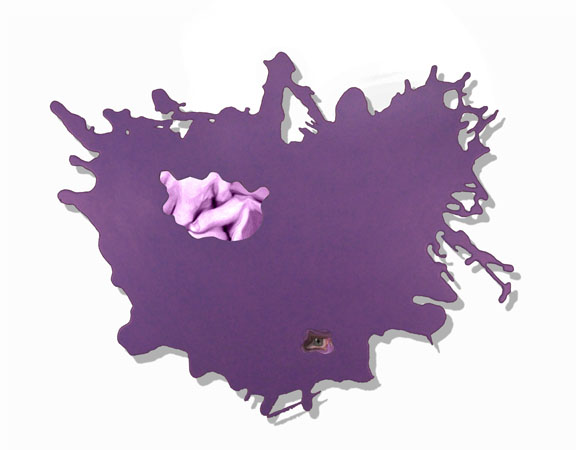
TONY OURSLER, Purple Ideation Exposure, 2007
aluminium, acrylic, LCD screen, DVD player
59 x 47 x 4.5 inches
149.9 x 119.4 x 11.4 cm
COURTESY OF THE ARTIST AND LEHMANN MAUPIN GALLERY,
NEW YORK
The small eye of Purple Ideation Exposure persistently looks forward. Eventually, its focus shifts. Occasionally the eye disappears to black. In the larger opening, partial images of two bodies intertwining, sometimes indistinct, appear and pass by in continual movement: hands; a shoulder; part of the torso; a foot morphed like a hand; long hair.
Mimetic systems and objects
This to-and-fro reflects a basic tension in which the media entity functions: in the relationship between 'mimetic systems' and 'objects'; in the movement between Oursler's reproduction of the seductions of the "deep media structure" and the interruption or punctuation of that process.
Oursler remarks that:
Mimetic systems can be seen as amplifiers of human drives and as site of psychological projection on the part of the viewer. The appearance of the devil in relation to the evils of technology is the personification of fears. Technology can be seen as the fear of the unknown and thus as a mirror of the viewer’s fear of their own potential. (Oursler 2001: 174)
Object/presence - silence - another 'theatricality' -
more to come...
- a politics of the production and consumption of identity - and presence - in and through media, expressed in amplification and interruption.
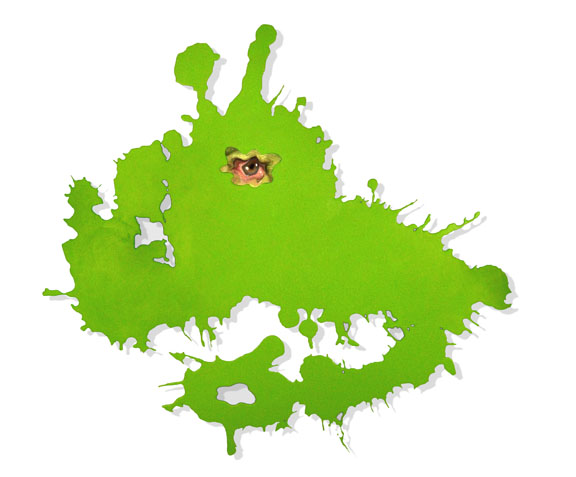
TONY OURSLER, Invisible Green Link?, 2007
aluminium, acrylic, LCD screen, DVD player
57 x 61 x 4.5 inches
144.8 x 154.9 x 11.4
COURTESY OF THE ARTIST AND LEHMANN MAUPIN GALLERY,
NEW YORK
The eye, rather bloodshot, closes, opens, seems to fix on something. Then, looking up, to the left. The eye blinks, it's action apparently slowed down.
Spatial migrations
See also Tony Oursler's extensive website at [link]. For further discussion and documentation of Oursler's work evolving through the Presence Project, please follow this link to Tony Oursler
References




